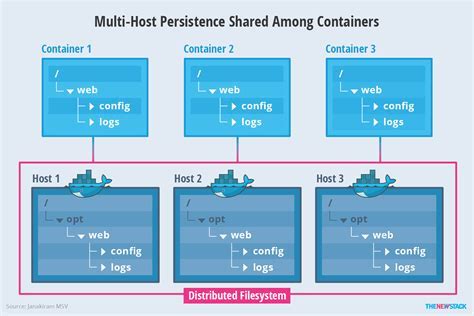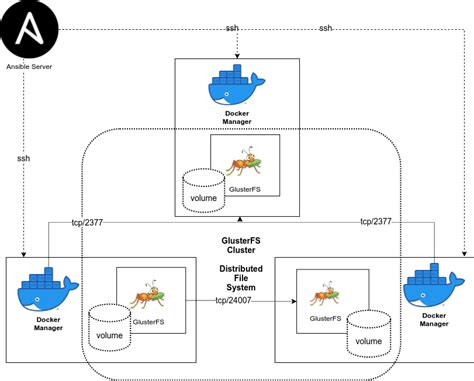Imagine a realm where agility, scalability, and resilience reign supreme. A place where applications and services seamlessly communicate and collaborate, forming an army of interconnected nodes. This is the world of distributed container orchestration, a paradigm that unlocks the full potential of your software infrastructure.
In this article, we will delve into the intricate world of Docker Swarm, exploring the unparalleled benefits it offers for persistent storage and the integration of Windows nodes. Through the use of innovative techniques and cutting-edge technologies, this guide aims to equip you with the knowledge and tools necessary to navigate the vast landscape of containerization with finesse.
Brace yourself for an expedition into the realm of distributed container orchestration, where we will uncover the power of seamless scalability, fault tolerance, and load balancing. Discover how Docker Swarm, the reigning champion of container orchestration, revolutionizes the way we deploy and manage applications.
Exploring Storage Solutions for Data Persistence in Docker Cluster

When it comes to running applications in a Docker Swarm cluster, ensuring persistent storage is crucial for maintaining data integrity and availability. In this section, we will delve into the different options available for achieving data persistence within a Docker Swarm environment.
One approach to consider is leveraging distributed filesystems, such as GlusterFS or Ceph, which provide a scalable and fault-tolerant solution for storing and retrieving data across multiple nodes in the cluster. These distributed filesystems distribute data across various storage nodes, making it resilient to failures and ensuring high availability.
Another option worth exploring is using external storage systems, like network-attached storage (NAS) or storage area networks (SANs), which can be seamlessly integrated with Docker Swarm. These storage systems offer centralized and efficient storage capabilities, providing a unified storage solution for the entire cluster. They can be particularly beneficial for handling large volumes of data and supporting diverse workloads.
In addition, Docker Swarm supports the use of volume plugins, which enable integration with various storage solutions, such as cloud providers, object storage systems, or specialized storage platforms. These plugins allow for seamless integration and management of persistent volumes, providing flexibility and convenience when it comes to data storage in a Docker Swarm cluster.
- Explore distributed filesystems like GlusterFS or Ceph.
- Consider using external storage systems like NAS or SAN.
- Investigate volume plugins for integration with specialized storage solutions.
By considering these storage options and selecting the most suitable one for your Docker Swarm cluster, you can ensure the reliability and availability of data, enabling seamless application deployment and scaling across the cluster.
Configuring Windows Nodes in Docker Swarm: Step-by-Step Walkthrough
In this section, we delve into the comprehensive process of configuring Windows nodes within a Docker Swarm cluster. We will explore the step-by-step instructions that enable you to seamlessly integrate Windows nodes into your existing Docker Swarm infrastructure.
Understanding Windows Nodes
Before we proceed with the configuration process, it is essential to grasp the concept of Windows nodes in the context of Docker Swarm. Windows nodes serve as crucial components that facilitate the deployment and management of containerized applications on Windows-based systems. By harnessing the power of Docker Swarm, you can harness the scalability and reliability advantages offered by containerization technology for your Windows workloads.
Step 1: Preparing the Windows Environment
In this initial step, we outline the tasks required to prepare your Windows environment for contributing to a Docker Swarm cluster. We discuss the prerequisites, such as ensuring Windows Server is up to date and verifying network connectivity between nodes. Additionally, we highlight any specific configurations that are necessary for seamless integration into the existing Docker Swarm cluster.
Step 2: Installing Docker on Windows Server
This step focuses on the installation process of Docker on the Windows Server operating system. We provide detailed instructions on obtaining the necessary Docker components, including Docker Engine and Docker CLI, and guide you through the installation steps. Additionally, we delineate the best practices to consider when configuring Docker on Windows nodes.
Step 3: Joining Windows Nodes to the Docker Swarm
Once Docker is successfully installed, the next step entails joining the Windows nodes to the Docker Swarm cluster. We discuss the commands and configurations required to establish a secure and efficient connection between the Windows nodes and the existing swarm infrastructure. We also highlight potential challenges that may arise during the joining process and how to troubleshoot them.
Step 4: Verifying Windows Node Integration
In this final step, we demonstrate the methods to verify the successful integration of Windows nodes into the Docker Swarm cluster. We present various techniques to validate the connectivity, functionality, and proper functioning of the Windows nodes within the Swarm infrastructure. Additionally, we provide troubleshooting tips to address any issues that may arise during the verification process.
By following this step-by-step walkthrough, you will acquire the knowledge and skills to effectively configure Windows nodes in your Docker Swarm cluster. This will empower you to leverage the full potential of Windows-based containerization and seamlessly integrate your Windows workloads into your existing infrastructure.
Best Practices for Managing Persistent Storage in Docker Swarm

In this section, we will discuss some recommended practices for effectively managing and maintaining persistent storage in a Docker Swarm environment. Efficient data storage is crucial for the successful deployment and operation of containerized applications, and understanding the best practices will help you optimize the performance and reliability of your Swarm cluster.
- Ensure Scalability: Plan your storage architecture to accommodate the growing needs of your Swarm cluster. Design scalable storage solutions that can seamlessly handle the increasing amount of data generated by your containers.
- Choose Reliable Storage Drivers: Select storage drivers that are known for their stability, performance, and compatibility with the Swarm environment. Consider the specific requirements of your application and choose the appropriate driver accordingly.
- Implement Backup and Disaster Recovery Strategies: Establish robust backup and disaster recovery mechanisms to safeguard your persistent data. Regularly back up your data and test the restoration process to ensure its integrity.
- Monitor Storage Performance: Continuously monitor the performance and utilization of your storage systems. Use tools and metrics to identify bottlenecks or potential issues and take proactive measures to optimize performance.
- Implement Data Replication: Leverage the power of data replication to enhance data availability and durability. Replicate your data across multiple nodes to ensure that it is accessible even in the event of node failures.
- Consider Security: Apply appropriate security measures to protect your persistent data from unauthorized access. Implement encryption, access controls, and regular security audits to mitigate risks and comply with industry standards.
- Automate Storage Management: Utilize automation and orchestration tools to streamline storage management tasks. Automate routine operations such as storage provisioning, data migration, and capacity scaling to improve efficiency and reduce human errors.
- Stay Updated: Keep track of the latest advancements in storage technologies and practices. Regularly update your storage drivers, tools, and hardware to take advantage of performance improvements and new features.
By following these best practices, you can optimize the management of persistent storage in your Docker Swarm environment, ensuring the availability, performance, and reliability of your containerized applications.
Enhancing Scalability and High Availability in Docker Swarm with Windows Nodes
In this section, we will explore how the introduction of Windows nodes can significantly improve scalability and high availability in Docker Swarm. By incorporating Windows nodes into a Swarm cluster, organizations can leverage the power of both Linux and Windows containers, allowing for increased flexibility and improved resource allocation.
One of the key benefits of adding Windows nodes to a Docker Swarm cluster is the ability to deploy and manage a wider range of applications. With the inclusion of Windows containers, organizations can now run applications that are specifically built for Windows platforms, without compromising the seamless integration and compatibility of Linux containers.
With Windows nodes, Docker Swarm can achieve enhanced scalability by distributing containers across a heterogeneous cluster. By combining both Linux and Windows nodes, organizations can optimize resource allocation and ensure maximum utilization of available hardware resources, resulting in improved performance and scalability for their applications.
Moreover, the introduction of Windows nodes in Docker Swarm enables organizations to achieve high availability. By deploying replicas of containers across both Linux and Windows nodes, organizations can ensure that their applications remain accessible and operational even in the event of a node failure. This distributed approach to container deployment enhances fault tolerance and resilience.
In conclusion, the incorporation of Windows nodes in Docker Swarm enhances scalability and high availability by enabling the deployment of a wider range of applications and optimizing resource allocation. This combination of Linux and Windows containers provides organizations with the flexibility to leverage the strengths of both platforms, resulting in improved performance and fault tolerance for their applications.
FAQ
What is Docker Swarm?
Docker Swarm is a native clustering and orchestration solution for Docker.
Why do we need persistent storage in Docker Swarm?
Persistent storage is essential in Docker Swarm to store and retrieve data even if containers are replaced or moved between nodes in the cluster.
How can I configure persistent storage for Windows nodes in Docker Swarm?
To configure persistent storage for Windows nodes, you can use third-party volume drivers like Convoy or consult the official Docker documentation for Windows-specific storage options.
What are the challenges of using persistent storage in Docker Swarm with Windows nodes?
The challenges include finding compatible volume drivers, ensuring proper configuration of storage options, and addressing any potential performance limitations on Windows nodes.




